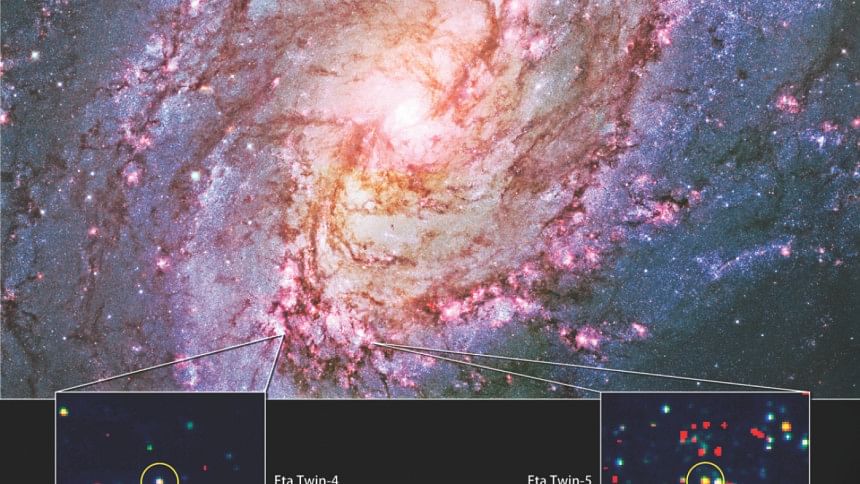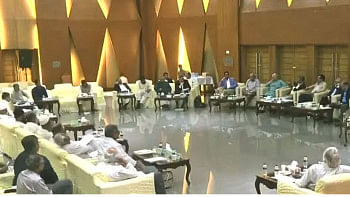Super star has 5 twins

As a star, the sun is so big that it can accommodate 13 lakh earths. Now imagine a star that is around a hundred times larger than the sun and outshines the sun five million times.
Such massive stars produce and distribute a large amount of elements vital for formation of life when they eventually explode as supernovae. Unfortunately, these hypergiants are extremely rare as their size makes them unstable.
According to Nasa, the lone example of such a star until recent times, which has not exploded, was Eta Carinae.
Eta Carinae is actually made up of two massive stars (a binary system).

The larger one (Eta Carinae A) is estimated to be 100 to 150 times more massive than the sun, and the smaller companion (Eta Carinae B) 30 times the sun's mass.
Eta Carinae A blasted out at least 10 times the mass of our sun into space in 1838. The eruption of the star over a decade made it the second brightest star, after Sirius, in the sky for some time.
Located about 7,500 light years away from Earth, Eta Carinae is a widely studied giant. Yet nobody knows why it had erupted. Scientists needed to find more stars like Eta Carinae for better understanding.
That is where a team led by Bangladeshi astrophysicist Rubab Khan, 29, of Nasa Goddard Space Flight Centre made a great breakthrough.
Rubab's team found not just one, but five similar super stars that match the size and mass of Eta Carinae. These are located between 15 and 26 million light years away in other galaxies.
During the annual meeting of the American Astronomical Society in the USA on Wednesday, Rubab placed his findings on the discovery of five "Eta twins". The Hubble Space Telescope and Nasa's Spitzer Space Telescope helped in identifying them.
"By better understanding massive star evolution, we can learn about the process of making all the elements and the dust that then made the world we now live in," Rubab said.
"Eta Carinae is not a one-off freak of nature -- rather, its present state represents a condition that occurs in nature possibly for most or even all very high-mass stars," Rubab said, according to Inside Science website.
SEARCH FOR GIANTS
Working with Scott Adams and Christopher Kochanek at Ohio State and George Sonneborn at Goddard, Rubab developed a kind of optical and infrared fingerprint for identifying possible Eta twins.
According to Nasa, Rubab and his team surveyed seven galaxies from 2012 to 2014 to look for Eta twins.
In a follow-on survey in 2015, the team found two candidates in the galaxy M83, located 15 million light years away, and one each in NGC 6946, M101 and M51, located between 18 and 26 million light years away.
These five objects mimic the optical and infrared properties of Eta Carinae, indicating that each very likely contains a high mass star buried in five to 10 solar masses of gas and dust. Further study will let astronomers determine more precisely their physical properties. The findings were published in the December 20 edition of The Astrophysical Journal Letters.

Rubab was quoted by Inside Science as saying, "We expected to first find just one, and then another after some time, and so on. So when we found five in one sweep, after so many years and so many galaxies of not finding any, we were quite startled. In fact we spent quite some time checking, double-checking, and double-double-checking to make sure that everything was in order."
By comparing what researchers know about Eta Carinae and will learn about the Eta twins, they can begin to solve a number of mysteries surrounding massive stars. "Do all very high mass stars lose a significant portion of their material as they age?" Rubab said. "Do all of them lose that mass through a single giant eruption, or through many small eruptions, or through a heavy wind? How long do they live after these eruptions?
"The next step is to further study the Eta twins with present generation telescopes, and then with the James Webb Space Telescope when it is launched in 2018," Rubab said. "We would also like to find more Eta twins, especially in galaxies that are unlike the ones in which we have found them now, to figure out if it takes special physical conditions to produce these objects."
RUBAB KHAN: THE DREAM CHASER
When most of our childhood dreams die as we grow older, Rubab's life turned out to what he wanted to be. From his childhood, he dreamt of chasing stars from his rooftop.
“He used to observe stars though our grandfather's telescope and match them with the picture of stars he found in astronomical books,” says his elder sister Sumaiya Farah Khan, assistant professor of Microbiology at Jagannath University.
“As a child he always wanted to be an astronaut.”
The proud sister also said, “Usually people dedicate their PhD thesis to parents but Rubab didn't do that. He dedicated his paper to Bangladesh.”
Rubab completed his SSC and HSC from Udayan School and Notre Dame College Dhaka. When he was in class-VI, he decided to be an astronaut and always remained busy with astronomical books and newsletters.
In 2004, his dream began to come true. He got a scholarship in Columbia University majoring in Astrophysics. He graduated from Columbia in 2008.
He received his PhD from The Ohio State University, department of astronomy, in 2014. He worked with professors Krzysztof Stanek and Christopher Kochanek at the Ohio State University.
Currently, he is a James Webb Space Telescope (JWST) Fellow at the Nasa Goddard Space Flight Centre. Till date, he has authored 35 refereed papers, including nine as the first author and two as the second author.
He is specialised in crowded-field photometry and multi-wavelength astrometry of Hubble, Spitzer, Herschel space telescopes' data.
According to Rubab, his primary research focus is massive star geriatrics. It means the study of the affects of old age on the most massive stars.

 For all latest news, follow The Daily Star's Google News channel.
For all latest news, follow The Daily Star's Google News channel. 








Comments